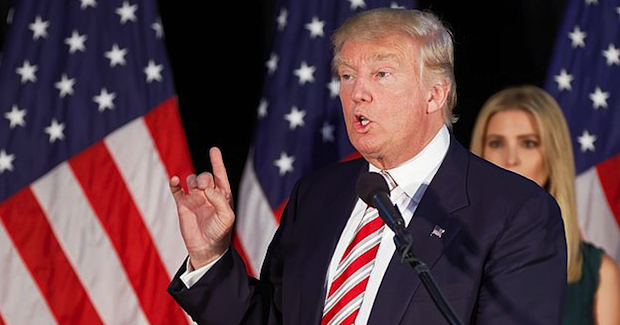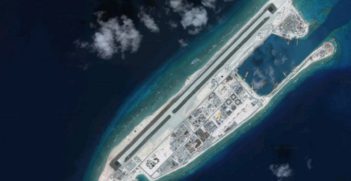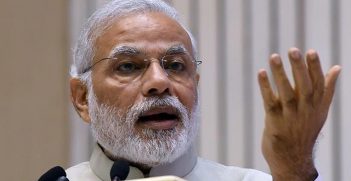Trump's Macroeconomic Gamble

During his election campaign, Donald Trump simultaneously promised a major reduction in federal taxes for businesses and a trillion-dollar increase in public infrastructure spending. This contradictory double may lead to widening income inequality and a severe worsening of America’s public debt.
In 2017, Trump will be in charge of the dollar—the world’s reserve currency—the world’s largest economy, and its largest blocs of debt. He inherits an economy with 3.2 per cent third quarter gross domestic product (GDP) growth and 4.6 per cent unemployment.
‘Trumponomics’ equals infrastructure and defence spending, tax cuts, deregulation, and protectionism. While the big surge of spending on infrastructure is a positive policy to bring to the table, to combine it with tax cuts and deregulation is not only wrong, it is dangerous—especially at a time when the US is already close to full employment.
The macroeconomics of Trump’s plan points to larger fiscal deficits as a result of both higher infrastructure spending and corporate and personal tax cuts. Trump has pledged to invest US$1 trillion (A$1.3 trillion) in infrastructure at a time when increasing infrastructure investment has been prescribed by the International Monetary Fund (IMF) and prominent economists to support job creation and growth in the near term. Moreover, infrastructure spending was a component of both Clinton and Sanders’ economic plans. It would be ironic if Trump—with Republican support in Congress—carried out precisely the sort of Keynesian fiscal stimulus Obama proposed in 2009, which was adamantly opposed by Republicans.
Ending austerity and pushing for public investment is a very positive development. It sends a much needed signal to the rest of the world. However, with the tax cuts that proposal becomes misguidedly dangerous. According to the Tax Policy Center, Trump’s personal and business tax cuts would lead to an increase in the federal debt of US$7.2 trillion over the first decade. The cumulative increase in federal debt might be as much as 25 per cent of GDP by 2026, which may open up large and permanent increases in fiscal deficits.
It seems evident that Trump’s tax plans would above all benefit the very rich. Unlocking investment is the key to unlocking a strong cycle of domestic growth, as the IMF has argued. However, lowering taxes on the ultra-rich, instead of increasing them, will have harmful social and political effects if it worsens inequality while letting public finances explode.
With the US economy already operating close to potential, deficits will lead to higher inflation. More deficit-financed public spending would put upward pressure on economic activity and inflation, which would prompt the US Federal Reserve to start tightening monetary policy by increasing interest rates faster than it intended to before the election.
The Fed would need to suppress demand and increase interest rates to prevent the US economy from overheating. In a recent speech on Capitol Hill, Janet Yellen, chair of the Federal Reserve, cautioned lawmakers that if they spend too much on infrastructure and run up the debt via tax cuts, there would not be enough fiscal space should an adverse shock to the economy require fiscal stimulus.
As a supply-side measure, Trump has vowed to slash regulation, including the 2010 Dodd-Frank Wall Street Reform. This is negligent as the global economy is still suffering from the financial crisis of 2008. Yellen defended Dodd-Frank stating, “our financial system as a consequence is safer and sounder, and many of the appropriate reforms are embodied in Dodd-Frank. We wouldn’t want to go back to the mortgage lending standards that led to the financial crisis.”
Trump’s push for a level playing field on trade is not necessarily incorrect or partisan, in theory. After all, both Bernie Sanders and Hillary Clinton opposed the Trans-Pacific Partnership (TPP). Rather, the economic peril with Trump is his proposed methodology. Trump has threatened to use tariffs as high as 45 per cent on Chinese goods. Imposing tariffs on a major scale would be a significant blow to US growth and make a recession more likely.
A trade war with China would yield higher prices for consumers and fuel inflation, as well as punish companies that depend on Chinese imports and American exporters who consider China an important export market. On the supply side, it would disrupt production and decrease productivity, and global supply chains would be flung into uncertainty.
Trump’s economic plan suggests an attempt at doubling down on trickle-down economics—that hasn’t been trickling down—with a tinge of economic nationalism. The willingness to return to strong boom and bust cycles is extremely risky. While Trump’s proposals could boost US economic growth in the near future, his other policies would offset those positive impacts over the long term. Some are already looking at the prospect of stagflation—a scenario in which prices rise alongside unemployment while the economy slows—which could quickly set in if import prices rise and the immigrant labor force contracts.
The lack of redistribution of GDP growth and trade gains is still going to be the key problem. If there is one lesson to take from the anti-establishment theme of 2016 it is this: there is a need for domestic policy to ensure that the gains from trade and growth are widely shared. Domestic tax and transfer plans have not been capable of adjusting market income to a more evenly distributed household disposable income.
This becomes even more imperative at a time when technology, automation, and the digital divide are expected to disrupt labour markets. Falling incomes are corrosive for GDP growth and could also be fuelling social and political disgruntlement. A US economic boom has to deliver growth in household incomes, which is not guaranteed under Trump’s plan.
The redistribution of corporate balance sheets towards households is well overdue. However, lower corporate taxes, lower personal taxes on the rich, and financial deregulation will increase the share of output going to capital. Corporate tax cuts may well simply increase corporate profitability—cue the equity markets’ euphoria in rotating from bonds to equities—without any major consequence on investments, as companies, in general, already have abundant cash on hand. Allowing the negative combination of inactive wealth, stagnation of the real median income, sluggish productivity and continued loss of manufacturing competitiveness to continue is unwise. A worst-case scenario for ‘Trumponomics’ would send economic shockwaves around the world. This is the macroeconomic threat of Donald Trump’s plan.
Pedro Sousa is a Portuguese political economist who has worked at the OECD and the UN. His work is related to macroeconomics and politics as a writer, researcher, and strategic adviser.
This article is published under a Creative Commons Licence and may be republished with attribution.





